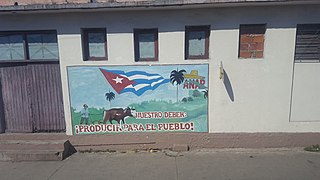 W
WBlas Roca Calderio was a Cuban politician and Marxist theorist who served as President of the National Assembly of People's Power in Cuba from 1976 to 1981. He was also head of the pre-1959 revolution Communist Party of Cuba for 28 years and editor of the communist newspaper Hoy. He was a signatory of the Cuban Constitution of 1940 and chaired the committee that wrote the country's first socialist constitution in 1976.
 W
WCandler College and Colegio Buenavista were educational institutions founded in Havana, Cuba by the United States Southern Methodist Episcopal Church. They were founded on two different dates, Candler College in 1899 and Colegio Buenavista in 1920. They both ceased to exist in 1961 when they were nationalized by the revolutionary government of Fidel Castro.
 W
WThe Cuban Missile Crisis, also known as the October Crisis of 1962, the Caribbean Crisis, or the Missile Scare, was a 1 month, 4 days confrontation between the United States and the Soviet Union which escalated into an international crisis when American deployments of missiles in Italy and Turkey were matched by Soviet deployments of similar ballistic missiles in Cuba. The confrontation is often considered the closest the Cold War came to escalating into a full-scale nuclear war.
 W
WOsvaldo Dorticós Torrado was a Cuban politician who served as the President of Cuba from 1959 until 1976.
 W
WThe grey years in Cuba refer to a loosely defined period in Cuban history that is generally agreed to have started with the Padilla affair in 1971. The period has been termed and dated as the quinquenio gris, the decada negra, or the trinquenio amargo. The period occurred during the tenure of Luis Pavón Tamayo as the head of the National Cultural Council. The period is generally defined by cultural censorship, official demotion of artists, and the harassment of LGBT people. The strengthening of internal repression inside Cuba was also occurring alongside greater influence from the Soviet Union in the political affairs and economy of Cuba. This soviet influence lead to mimicry in Cuba's new laws and policies at the time.
 W
WMilitary Units to Aid Production or UMAPs were agricultural labor camps operated by the Cuban government from November 1965 to July 1968 in the province of Camagüey. The UMAP camps served as a form of alternative civilian service for Cubans who could not serve in the military due to being, conscientious objectors, Christians and other religious people, homosexuals, or political enemies of Fidel Castro or his communist revolution. The language used in the title can be misleading, as pointed by historian Abel Sierra Madero, "The hybrid structure of work camps cum military units served to camouflage the true objectives of the recruitment effort and to distance the UMAPs from the legacy of forced labor." There is no official account of the internships of the UMAP's, but it has been estimated that the majority of the servicemen were conscientious objectors.
 W
WThe National Art Schools of Cuba is one of the most important educational institutions of the Cuban nation and has been declared as "National Monument".
 W
WThe National Association of Small Farmers (ANAP) is a cooperative federation dedicated to promoting the interests of small farmers in Cuba. ANAP has over 300,000 members.
 W
WOperation Peter Pan was a clandestine mass exodus of over 14,000 unaccompanied Cuban minors ages 6 to 18 to the United States over a two-year span from 1960 to 1962. They were sent by their parents who were alarmed by rumors circulating amongst Cuban families that the new government under Fidel Castro was planning to terminate parental rights, and place minors in communist indoctrination centers.
 W
WRaúl Roa García was a Cuban intellectual, politician and diplomat. He served as Foreign Minister of Cuba from 1959 to 1976. He was a lawyer and was also a university professor in the 1940s and 1950s. He was also Director of Culture of the Ministry of Education from 1949 to 1951.
 W
WLa Tremenda Corte was a radio comedy show produced from the Radiocentro CMQ Building in Havana, Cuba. The scripts were written by Cástor Vispo, a Spaniard who became Cuban citizen. The show was aired nonstop from 1942 to 1961. Later, the format of the show was adapted for a TV sitcom in Monterrey, Mexico, however, only three and a half seasons were produced from 1966 to 1969.